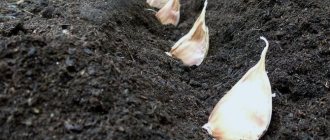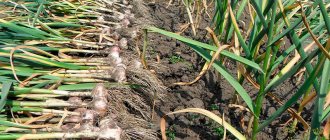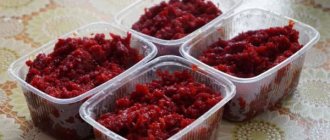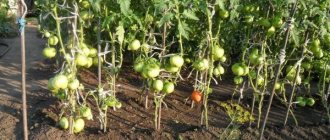Features of beet crop rotation
Beetroot is an easy-to-grow crop; it is grown everywhere and in a variety of conditions . However, there are a number of features that must be taken into account when cultivating root crops in order to obtain a rich and high-quality harvest.
Basic requirements of agricultural cultivation technology:
- The area for beds for root crops is located in a sunny place. This determines how bright, sweet and large the vegetable will grow.
- No less important for beets is the level of soil acidity - in acidic soil the vegetable develops poorly, its flesh turns black. If there is an excess of lime, the plant weakens and is affected by scab. For full growth and development of root crops, the soil pH should be 6.5-7.
- Most of all, beets require moisture during the period of rooting seedlings or seed germination (depending on the planting method). During root development, moderate watering is required. Closer to harvesting, watering is reduced - excess moisture will lead to rotting of the fruits in the ground.
- The ideal soil for beets is loam with humus - medium-density soil. On heavy clay soil, it will be difficult for the root crop to gain weight, and in excessively light sandy loam soils, the vegetable will not receive the required amount of nutrients, since they will constantly be washed into deeper layers by rain and watering.
- For the full development of the root crop, an area of at least 9x9 cm per unit is needed.
It can be useful:
Beets grow poorly - how to feed them
How, when and what to feed beets in July-August
Why do beet leaves turn red?
Planting beets with seeds in open ground
The vegetable is grown by seeds or seedlings. Before you start planting beets, you need to prepare a site for them. The culture is more likely to develop in sunny and generously lit places; in the shade, the root crops will not have a rich red-brown hue. The plant likes fertile, fluffy, non-acidic soils - loams, peat bogs, chernozems with a neutral or slightly alkaline reaction; groundwater should not be high on the site.
In the fall, the ground is dug up and cleared of weeds. In areas that were fertilized with manure or (especially after root crops), it is recommended to sow vegetables no earlier than after 3 years. Before planting beets with seeds in open ground, in the spring, when loosening, add 20-30 g of ammonium sulphate, 10-15 g of potassium chloride, 15-20 g of ammonium nitrate and 30-40 g of superphosphate per 1 m2 into the ground. . To neutralize the acidic environment, half a kilogram of lime is added per 1 m2.
Treatment of beet seeds before planting
Experienced gardeners recommend soaking the seeds the day before sowing to allow them to swell. The procedure will speed up the germination of the seedlings. For soaking, prepare a nutrient solution - take 1 teaspoon each of ordinary baking soda, wood ash and superphosphate, dilute in 1 liter of water. The seeds are kept in the composition for a day and washed well. For soaking, you can use purchased “Agricola Vegeta” - 1 teaspoon of the drug per liter of water. Afterwards, the grains are wrapped in moistened gauze for another couple of days for germination and placed in a warm place.
Beet seed planting depth
Before planting beets, you need to make furrows, moisten them and wait for the water to be absorbed. The soil should be fluffy and loose. You cannot plant seeds deep into the soil - due to lack of oxygen, they may not hatch. Sowing too small also does not bode well - the grains will be blown away by the wind or they will dry out in the heat. How to plant beets with seeds - ideal depth parameters:
- the seed is planted 2 cm deep during spring planting;
- Before winter, the seeds are buried 3-4 cm and the area must be covered with peat or humus.
How many days does it take for beets to sprout after sowing?
Food beets are not afraid of the cold, but the warmer it is outside in the spring, the faster the seedlings will hatch. Seed germination occurs already at +5°C, but with such an early start, sprouts will appear only after 3 weeks. Planting beets in open ground at a later time, when the ground has warmed up to +10-15°C, will reduce the waiting time for buds to 5-6 days. If it is more than +20°C outside, the seedlings will hatch on the third day.
What to plant after beets next year
The basic principle of competent crop rotation on a site is the correct calculation of crop changes. Vegetables with similar diseases and nutrient requirements should not be alternated. Beets will be an ideal predecessor for legumes (peas, beans), since they restore the balance of microelements in the soil.
They also grow well after this root vegetable.:
- tomatoes;
- potato;
- eggplant;
- pumpkin;
- cucumbers
Reference. Is it possible to plant strawberries after beets? Yes, you can. But keep in mind that beets are a neutral predecessor. Before planting strawberry beds, former beet beds need to be well fertilized.
What is better not to plant
It is not recommended to plant carrots after beets - both root vegetables require similar nutrition. The carrot will lack useful substances, since before it, all the microelements necessary for growth from the soil will be taken by its predecessor.
This rule can be neglected in special cases when there is no other suitable place in the garden. To reap a good harvest of carrots from the bed where beets grew the previous year, the soil is enriched with compost in the fall.
Disembarkation and care
There are two options for planting beets: seeds or seedlings. Each method has its own characteristics, which are described in more detail below.
Beetroot
Use of seeds
The planting material must be prepared in advance. To do this, the seeds are placed in a special solution of a growth stimulator and remain in it for 24 hours. After this, you need to rinse the grains with warm water and place them in a dry cloth. It is worth noting that the prepared material cannot be stored at low temperatures and high humidity (otherwise you will get seeds of poor quality, with a very low yield percentage).
Use of beet seeds
Sowing is organized in rows, which are preliminarily drawn on moist soil, with a distance between strips of approximately 20 cm (table). The depth of the grooves should be at least 4 cm; their cavity is abundantly filled with water. After the liquid is completely absorbed into the soil, you can introduce the seeds individually, since the grain size is large enough to allow this. When all the seeds are introduced into open ground, the grooves are filled with earth.
Due to the fact that several fruits sprout from one seed, the rows need to be thinned after germination, although this procedure can be avoided if the correct distance between the grains is initially selected. In case of very dense shoots, the removed shoots can also be planted and they will give a good harvest.
The most favorable time to sow beets in the spring is the beginning of May, since the soil still retains moisture quite well. After completion of sowing work, the soil surface must be weeded and loosened. As soon as the first shoots begin to appear, you can introduce soil fertilizing consisting of organic and mineral fertilizers.
Planting seedlings
To save time and effort, you can use ready-made seedlings. They resort to this method if they do not want to bother with the seeds or do not know how to germinate them correctly. In addition, seedlings eliminate the need for thinning the beds and minimize the number of unsprouted shoots, which directly affects the tonnage of the harvested crop.
Seedlings can be purchased or grown in a greenhouse from seeds. In case of self-preparation, grooves are made in the greenhouse, with a distance between the lines of 5 cm. Seeds are placed every 3 cm and covered with earth. After a certain time, seedlings will form, when 4 leaves grow on them, the planting material will be ready to move to the main soil.
Each sprout must be placed in a clay solution, only then planted in the ground. If planting is carried out in late autumn, the soil must be enriched with organic fertilizers.
Then plant beets
According to the rules of crop rotation, beets are planted only after those crops that have not taken from the soil the nutrients required for the full development of the root crop.
The best predecessors for beets are vegetables from the nightshade family.:
- pepper;
- eggplant;
- potato;
- tomatoes.
The beds after nightshade are thoroughly cleaned , the soil is prepared for the spring planting of beets, fertilizing it with compost and humus.
On a note . The ideal predecessor for all crops will be onions - the essential oils contained in them repel most types of pests of garden crops.
You can alternate planting root vegetables in the same bed with cucumbers, squash, and zucchini : all these vegetables are good predecessors for beets, since their root system is located in the upper layers of the soil and does not affect the nutrients it needs.
If it is possible to leave some piece of land fallow, you can plant clover on it. The plant will enrich the soil with useful microelements. Beets planted the following year after clover will grow large and sweet.
What is allowed to be planted in the garden and why?
Between the vegetable
- Leaf, head or asparagus lettuce. Lettuce grows faster, protecting young beet shoots. When the lettuce ripens, the beets take root and become strong enough.
- Bow on feather. First, the onion develops, covering the young shoots of the beet. As the onions recede, the beets take over and the overall yield increases.
- Leeks, marjoram, radishes, coriander, dill, parsley. The greens compact the beet beds, protecting the soil from weeds and drying out.
Cucumbers, tomatoes, legumes (peas, beans), asparagus, garlic. Beets are planted along the edge of the bed, on the sunny side, so that tall neighbors do not shade the shorter beets.
- Strawberries, different types of cabbage (cauliflower, cabbage, broccoli, kohlrabi). In this neighborhood, the sunny side should be given to strawberries and cabbage, they are more dependent on the sun.
- Radish. Radishes germinate quickly and serve as markers for rows of slowly germinating beets.
- Carrot. Compatibility with carrots is a controversial issue. There is an opinion that root vegetables affect each other’s taste and, when planted close together, interfere with each other’s development. With sufficient distance between plantings, beets and carrots coexist peacefully.
- It is advisable to choose root vegetables with different ripening periods. Beets should be planted on the sunny side because carrot tops are taller and can choke the beets.
- Oregano, mint, catnip, marigold. Repels beet pests.
- Potato. It goes well with beets, provided there is good soil fertility.
- Regular and root celery, radish, spinach, dill, parsley. They grow normally next to beets and make suitable companions.
Beets grow well along the edges of the beds. This way it gets enough sunlight and protects the sides of its neighbors from drying out and weeds.
Where to plant beets next to
The most suitable vegetable for simultaneous planting in the neighborhood is kohlrabi . This cabbage can be planted in the same bed with beets as follows: kohlrabi in the center, beets along the edges. Vegetables have a good effect on each other.
Kohlrabi is an early-ripening crop; it is harvested during the summer, and the beets have room to grow freely.
Also a good neighborhood will come from :
- lettuce;
- parsley;
- radishes;
- asparagus;
- broccoli;
- Brussels sprouts.
Neighbors such as mint, oregano, and marigold will successfully drive away most types of pests . If you plant marigolds next to vegetables, their roots will rid the beds of nematode larvae. The beets themselves will become an excellent neighbor for strawberries and grapes.
Gardeners have different opinions about the proximity of beets and carrots in the same bed . On the one hand, both crops require similar nutrients, on the other hand, carrots will not have enough light in the shade of beet tops. There is also the opposite opinion that such proximity has a healing effect for carrots.
Bad neighbors for beets
Beetroot is an unpretentious crop, but it also has undesirable neighbors . Thus, an excellent green manure mustard planted next to or before sowing beets will inhibit the root crop.
You shouldn’t plant peppers next to beets either - in such a neighborhood, although they won’t hurt, they will suffer themselves.
Another neighbor harmful to beets is corn . When it rises, it will shade its neighbor, which requires a lot of sun to mature successfully.
Reference. Table beets do not combine with their related crops: sugar beets and chard (herbaceous subspecies). If you sow rye next to beet beds, both crops will harm each other.
Neighborhood with beets
Beetroot feels good next to the following crops:
- carrot;
- cabbage;
- celery;
- salad;
Beets feel good in the garden next to the onions
- kohlrabi;
- White cabbage;
- onion;
- garlic;
- spinach;
- radish;
- cucumbers;
- strawberry.
Read more: Planting and growing table beets
Flowers will be good neighbors for beets.
Attention! Beets have spreading foliage, therefore, it is necessary to keep a distance when planting plants.
Beetroot grows poorly next to plants:
- mustard;
- corn;
- beans;
- potato;
- chives.
There are also helper plants:
- Chestnuts protect beets from beet moths.
- Even a small amount of coriander growing nearby repels rodents from beets.
- Hemp drives away the beet flea beetle.
- The mole cricket avoids the marigolds.
- To get rid of nematodes and butterflies around beet plantings, you need to plant chicory, nasturtium, marigolds, marigolds, and Persian chamomile.
Possible mistakes and what they mean
Most often, inexperienced gardeners, in an effort to improve the harvest, either apply too much fertilizer or “feed” the soil with everything, believing that “you can’t spoil the porridge with oil.” Some mistakes lead to “burnout” of seedlings or the production of root crops poisoned by nitrates.
Important! Under no circumstances should beets and other crops be planted in beds with fresh manure. The soil for spring planting is prepared in the fall. Mullein is considered the best organic fertilizer for all vegetable crops. For autumn digging, experienced gardeners use a mixture of cow manure and bedding material (straw). This fertilizer is applied in a ratio of 3-4 kg per 1 square meter. m.
Precursors harmful to beets
Some plants deplete the soil with particular intensity and leave behind various soil infections, which will subsequently reduce the yield or completely destroy the beetroot crop.
Such “heavyweights” include the following crops:
- All varieties of carrots;
- Spinach;
- Rape;
- White cabbage;
- Chard.
All of the plants described above have approximately the same need for certain microelements and are affected by similar types of pests, which, when planted annually, greatly depletes the level of nutrients in the soil.
It is worth noting! Planting beets 2 years in a row on the same land (the type of root crop does not matter) is a bad idea, since the last harvest will have limp fruit containing low levels of essential beneficial qualities. In addition, most likely, in the third year you will have to leave the land alone to restore its fertility. But you don’t have to think about what to plant after the beets.
Tips and tricks
Experienced gardeners recommend strictly following the rules of crop rotation . This is the only way to get the most out of your summer cottage and get an excellent harvest every year. Ideally, culture can be returned to its original place only after five years. For some vegetables this period is reduced to 3-4 years.
It is clear that in a few years it will be difficult to remember in which bed this or that vegetable grew, so there is a planting diary in which you additionally note when and with what certain beds were fertilized.
Many summer residents grow a little bit of everything on their plots. In this case, two or more crops are often planted on one bed at once . It is important to follow the rules of mutually beneficial proximity of vegetables. In order not to forget next year in which part of the bed this or that crop grew, draw a plan of the plot in your diary and label each part of it.
The result of the experiment: compact planting of beets between TOMATOES!
A few words about fertilizing
The soil is prepared in advance, the necessary fertilizers are added to it in accordance with the requirements of each crop . Also, when applying fertilizers, the deadlines are observed.
For example, plants need nitrogen fertilizing during the period of vegetative mass accumulation . The addition of nitrogen during bud formation will provoke abundant growth of green mass to the detriment of fruit set. Excess nitrogen-containing fertilizers can provoke the development of fungal diseases.
Potassium and phosphorus fertilizers are applied during the formation of root crops in beets, carrots and potatoes, as well as fruit set in tomatoes, peppers, eggplants, and cucumbers. Organic matter is added to the soil in the fall, since this fertilizer takes time to decompose.
To protect crops from pests, chemicals are most often used, and it is important to observe the timing and dosage. The first treatment is carried out 10-15 days after planting the seedlings in the ground. The last spraying is carried out no later than two weeks before harvest.
Planting beets with seedlings
To obtain an early harvest, it is advisable to grow beet seedlings. This method is considered more reliable, and the harvest is harvested 2-3 weeks earlier than the typical time. The seed material undergoes the same advance processing as in the case of sowing in an open area - soaking and germination. How to plant beets with seedlings:
- The substrate in the box is irrigated with Fitosporin in advance, in order to avoid diseases of future crops, it is watered.
- Then furrows are made along it every 5 cm, and seeds are distributed into them. Holes are formed at intervals of 3 cm, 3-4 grains are placed in one hole, and in the future the seedlings will be thinned out. The seedlings are sprinkled with the same substrate on top and the box is placed in the greenhouse.
- For normal growth, seedlings need a moist environment and daily ventilation.
- Planting beet seedlings in the ground is carried out when four true leaves have formed on the buds and they have grown to 8-9 cm. The seedlings are hardened off within a week in advance - the box should be taken out into fresh air for a couple of hours a day.
- When planting in open ground, there is no need to deepen the shoots; it is better to dip the shoots in a clay solution before rooting.
- At first, it is better to protect the seedlings with covering material by constructing arcs of iron rods in the garden bed. By July, when the foliage of the plants closes and the fruits reach a size of 1.5 cm, the film is removed.
What soil and growing conditions do beets need?
Experienced gardeners advise properly preparing the soil for planting beets. This will allow you to use the site more rationally and obtain a high yield of root crops. Loamy and sandy loam soils enriched with organic fertilizers are optimal for growing beets. Their advantage is that they are easy to process, retain moisture well, are saturated with oxygen, and retain heat.
If you have to grow a vegetable on alumina, its development occurs at a later date, and the yield is lower. Sandy soil warms up too much and does not retain moisture well. During watering, all useful minerals are washed out of such soil and the root crop does not receive the nutrition it needs.
Optimal acidity levels for growing beets are in the range from 6 to 7 pH. If deviations in one direction or another are significant, the plant may even die.
Planting root crops in winter
You should not associate the cold season with the inability to grow a good harvest of root crops. Since this crop can be “trained” to fight diseases, it will be resistant to frost and can easily cope with lack of moisture. The main features for planting beets before winter are the correct choice of place for sowing seeds, as well as high-quality fertilized soil.
An important factor in good yield is the predecessor, after which the beets will be planted.
You can safely put her in the wake of:
- Onions;
- Tomatoes;
- Cucumbers;
- Sweet pepper;
- Zucchini;
- Potatoes.
The vegetables described above leave behind exactly those useful elements in the soil that have a beneficial effect on the full formation and protection of sprouts in the winter season.
Important! You cannot plant root crops before winter in soil that is highly acidic. Often acid levels rise after fertilizing while growing other vegetables.
In order to get rid of unwanted levels of acid, the process of liming the soil is used, immediately after harvesting the predecessor. This can be done by sprinkling the ground with chalk, wood ash, dolomite flour or lime, and then digging the soil quite deeply.
Beetroot, like any other root crop, requires the correct selection of crop rotation to achieve maximum yield levels. If you comply with all the conditions for preparing, caring for and cultivating the land for growing beets, then the harvest will always delight you with its quantity and quality.











